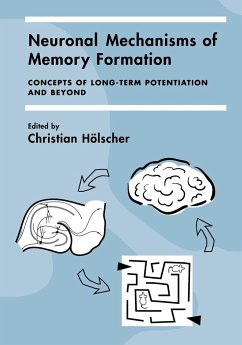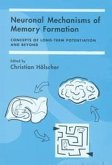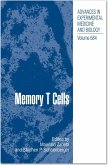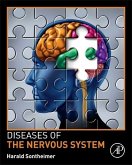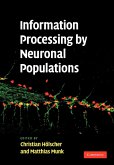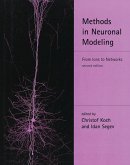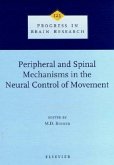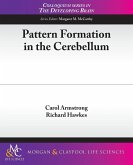Christian Hölscher (ed.)Concepts of Long-Term Potentiation and Beyond
Neuronal Mechanisms of Memory Formation
Concepts of Long-Term Potentiation and Beyond
Herausgeber: Holscher, Christian; H. Lscher, Christian; Christian, Holscher
Christian Hölscher (ed.)Concepts of Long-Term Potentiation and Beyond
Neuronal Mechanisms of Memory Formation
Concepts of Long-Term Potentiation and Beyond
Herausgeber: Holscher, Christian; H. Lscher, Christian; Christian, Holscher
- Broschiertes Buch
Andere Kunden interessierten sich auch für
![Neuronal Mechanisms of Memory Formation Neuronal Mechanisms of Memory Formation]() Christian Hölscher (ed.)Neuronal Mechanisms of Memory Formation132,99 €
Christian Hölscher (ed.)Neuronal Mechanisms of Memory Formation132,99 €![Memory T Cells Memory T Cells]() Memory T Cells270,99 €
Memory T Cells270,99 €![Diseases of the Nervous System Diseases of the Nervous System]() Harald SontheimerDiseases of the Nervous System170,99 €
Harald SontheimerDiseases of the Nervous System170,99 €![Information Processing by Neuronal Populations Information Processing by Neuronal Populations]() Information Processing by Neuronal Populations74,99 €
Information Processing by Neuronal Populations74,99 €![Methods in Neuronal Modeling, second edition Methods in Neuronal Modeling, second edition]() Methods in Neuronal Modeling, second edition55,99 €
Methods in Neuronal Modeling, second edition55,99 €![Peripheral and Spinal Mechanisms in the Neural Control of Movement Peripheral and Spinal Mechanisms in the Neural Control of Movement]() M.D. Binder (ed.)Peripheral and Spinal Mechanisms in the Neural Control of Movement317,99 €
M.D. Binder (ed.)Peripheral and Spinal Mechanisms in the Neural Control of Movement317,99 €![Pattern Formation in the Cerebellum Pattern Formation in the Cerebellum]() Carol ArmstrongPattern Formation in the Cerebellum77,99 €
Carol ArmstrongPattern Formation in the Cerebellum77,99 €-
-
-
Produktdetails
- Verlag: Cambridge University Press
- Seitenzahl: 508
- Erscheinungstermin: 31. Mai 2005
- Englisch
- Abmessung: 254mm x 178mm x 27mm
- Gewicht: 945g
- ISBN-13: 9780521018036
- ISBN-10: 052101803X
- Artikelnr.: 21693102
Hinweis: Dieser Artikel kann nur an eine deutsche Lieferadresse ausgeliefert werden.
- Herstellerkennzeichnung
- Libri GmbH
- Europaallee 1
- 36244 Bad Hersfeld
- gpsr@libri.de
General Introduction: Long-term potentiation as a model for learning
mechanisms: 'the story so far' Christian Hölscher; Part I. LTP In Vitro and
in Vivo: How Can We Fine-Tune the Current Models for Memory Formation?: 1.
Persisting with LTP as a memory mechanism: clues from variations in LTP
maintenance Wickliffe C. Abraham; 2. LTP in the amygdala: implications for
memory Michael T. Rogan, Marc G. Weisskopf, Yan-You Huang, Eric R. Kandel
and Joseph E. LeDoux; 3. Multiple roles for synaptic plasticity in
Pavlovian fear conditioning Stephen Maren; 4. Plasticity of the hippocampal
cellular representation of space Kathryn J. Jeffrey; Part II. There is More
to the Picture than LTP: Theta or Gamma Oscillations in the Brain and the
Facilitation of Synaptic Plasticity: 5. Synaptic potentiation by natural
patterns of activity in the hippocampus: implications for memory formation
Fenella Pike, Sturla Molden, Ole Paulsen and Edvard I. Moser; 6. Plasticity
in local neuronal circuits: in-vivo evidence from rat hippocampus and
amygdala Mouna Maroun, Dan Yaniv and Gal Richter-Levin; 7.
Theta-facilitated induction of LTP: a better model for memory formation?
Christian Hölscher; 8. Neuronal processing of information in the neocortex
and the role of gamma-oscillations in perception and memory formation
Matthias H. J. Munk; Part III. Making Models from Empirical Data of
Synaptic Plasticity: 9. Towards a physiological explanation of behavioural
data on human memory: the role of theta-gamma oscillations and
NMDAR-dependent LTP John Lisman, Ole Jensen and Michael Kahana; 10.
Neuronal networks, synaptic plasticity, and memory systems in primates
Edmund T. Rolls; 11. Revisiting the LTP orthodoxy: plasticity versus
pathology Jill C. McEachern and Christopher A. Shaw; 12. Long-term
potentiation and associative learning: can the mechanism subserve the
process? Louis D. Matzel and Tracey J. Shors; Part IV. Setting the Stage
for Memory Formation: Stress, Arousal and Attention: 13. Strategies for
studying the role of LTP in spatial learning: what do we know? Where should
we go? Donald P. Cain; 14. What studies in old rats tell us about the role
of LTP in learning Gregory M. Rose and David M. Diamond; 15. Implications
of the neuropsychology of anxiety for the functional role of LTP in the
hippocampus Neill McNaughton; 16. Differential effects of stress on
hippocampal and amygdaloid LTP: insight into the neurobiology of traumatic
memories David M. Diamond, Collin R. Park, Michael J. Puls and Gregory M.
Rose; Part V. Transgenic Mice as Tools to Unravel the Mechanisms of Memory
Formation: 17. In vivo recording of single cells in behaving transgenic
mice Yoon H. Cho and Howard B. Eichenbaum; 18. Understanding synaptic
plasticity and learning through genetically modified animals Paul F.
Chapman; 19. What can gene activation tell us about synaptic plasticity and
the mechanisms underlying the encoding of the memory trace Sabrina Davis
and Serge Laroche; Conclusions and future targets Christian Hölscher, Gal
Richter-Levin and Timothy V. P. Bliss.
mechanisms: 'the story so far' Christian Hölscher; Part I. LTP In Vitro and
in Vivo: How Can We Fine-Tune the Current Models for Memory Formation?: 1.
Persisting with LTP as a memory mechanism: clues from variations in LTP
maintenance Wickliffe C. Abraham; 2. LTP in the amygdala: implications for
memory Michael T. Rogan, Marc G. Weisskopf, Yan-You Huang, Eric R. Kandel
and Joseph E. LeDoux; 3. Multiple roles for synaptic plasticity in
Pavlovian fear conditioning Stephen Maren; 4. Plasticity of the hippocampal
cellular representation of space Kathryn J. Jeffrey; Part II. There is More
to the Picture than LTP: Theta or Gamma Oscillations in the Brain and the
Facilitation of Synaptic Plasticity: 5. Synaptic potentiation by natural
patterns of activity in the hippocampus: implications for memory formation
Fenella Pike, Sturla Molden, Ole Paulsen and Edvard I. Moser; 6. Plasticity
in local neuronal circuits: in-vivo evidence from rat hippocampus and
amygdala Mouna Maroun, Dan Yaniv and Gal Richter-Levin; 7.
Theta-facilitated induction of LTP: a better model for memory formation?
Christian Hölscher; 8. Neuronal processing of information in the neocortex
and the role of gamma-oscillations in perception and memory formation
Matthias H. J. Munk; Part III. Making Models from Empirical Data of
Synaptic Plasticity: 9. Towards a physiological explanation of behavioural
data on human memory: the role of theta-gamma oscillations and
NMDAR-dependent LTP John Lisman, Ole Jensen and Michael Kahana; 10.
Neuronal networks, synaptic plasticity, and memory systems in primates
Edmund T. Rolls; 11. Revisiting the LTP orthodoxy: plasticity versus
pathology Jill C. McEachern and Christopher A. Shaw; 12. Long-term
potentiation and associative learning: can the mechanism subserve the
process? Louis D. Matzel and Tracey J. Shors; Part IV. Setting the Stage
for Memory Formation: Stress, Arousal and Attention: 13. Strategies for
studying the role of LTP in spatial learning: what do we know? Where should
we go? Donald P. Cain; 14. What studies in old rats tell us about the role
of LTP in learning Gregory M. Rose and David M. Diamond; 15. Implications
of the neuropsychology of anxiety for the functional role of LTP in the
hippocampus Neill McNaughton; 16. Differential effects of stress on
hippocampal and amygdaloid LTP: insight into the neurobiology of traumatic
memories David M. Diamond, Collin R. Park, Michael J. Puls and Gregory M.
Rose; Part V. Transgenic Mice as Tools to Unravel the Mechanisms of Memory
Formation: 17. In vivo recording of single cells in behaving transgenic
mice Yoon H. Cho and Howard B. Eichenbaum; 18. Understanding synaptic
plasticity and learning through genetically modified animals Paul F.
Chapman; 19. What can gene activation tell us about synaptic plasticity and
the mechanisms underlying the encoding of the memory trace Sabrina Davis
and Serge Laroche; Conclusions and future targets Christian Hölscher, Gal
Richter-Levin and Timothy V. P. Bliss.
General Introduction: Long-term potentiation as a model for learning
mechanisms: 'the story so far' Christian Hölscher; Part I. LTP In Vitro and
in Vivo: How Can We Fine-Tune the Current Models for Memory Formation?: 1.
Persisting with LTP as a memory mechanism: clues from variations in LTP
maintenance Wickliffe C. Abraham; 2. LTP in the amygdala: implications for
memory Michael T. Rogan, Marc G. Weisskopf, Yan-You Huang, Eric R. Kandel
and Joseph E. LeDoux; 3. Multiple roles for synaptic plasticity in
Pavlovian fear conditioning Stephen Maren; 4. Plasticity of the hippocampal
cellular representation of space Kathryn J. Jeffrey; Part II. There is More
to the Picture than LTP: Theta or Gamma Oscillations in the Brain and the
Facilitation of Synaptic Plasticity: 5. Synaptic potentiation by natural
patterns of activity in the hippocampus: implications for memory formation
Fenella Pike, Sturla Molden, Ole Paulsen and Edvard I. Moser; 6. Plasticity
in local neuronal circuits: in-vivo evidence from rat hippocampus and
amygdala Mouna Maroun, Dan Yaniv and Gal Richter-Levin; 7.
Theta-facilitated induction of LTP: a better model for memory formation?
Christian Hölscher; 8. Neuronal processing of information in the neocortex
and the role of gamma-oscillations in perception and memory formation
Matthias H. J. Munk; Part III. Making Models from Empirical Data of
Synaptic Plasticity: 9. Towards a physiological explanation of behavioural
data on human memory: the role of theta-gamma oscillations and
NMDAR-dependent LTP John Lisman, Ole Jensen and Michael Kahana; 10.
Neuronal networks, synaptic plasticity, and memory systems in primates
Edmund T. Rolls; 11. Revisiting the LTP orthodoxy: plasticity versus
pathology Jill C. McEachern and Christopher A. Shaw; 12. Long-term
potentiation and associative learning: can the mechanism subserve the
process? Louis D. Matzel and Tracey J. Shors; Part IV. Setting the Stage
for Memory Formation: Stress, Arousal and Attention: 13. Strategies for
studying the role of LTP in spatial learning: what do we know? Where should
we go? Donald P. Cain; 14. What studies in old rats tell us about the role
of LTP in learning Gregory M. Rose and David M. Diamond; 15. Implications
of the neuropsychology of anxiety for the functional role of LTP in the
hippocampus Neill McNaughton; 16. Differential effects of stress on
hippocampal and amygdaloid LTP: insight into the neurobiology of traumatic
memories David M. Diamond, Collin R. Park, Michael J. Puls and Gregory M.
Rose; Part V. Transgenic Mice as Tools to Unravel the Mechanisms of Memory
Formation: 17. In vivo recording of single cells in behaving transgenic
mice Yoon H. Cho and Howard B. Eichenbaum; 18. Understanding synaptic
plasticity and learning through genetically modified animals Paul F.
Chapman; 19. What can gene activation tell us about synaptic plasticity and
the mechanisms underlying the encoding of the memory trace Sabrina Davis
and Serge Laroche; Conclusions and future targets Christian Hölscher, Gal
Richter-Levin and Timothy V. P. Bliss.
mechanisms: 'the story so far' Christian Hölscher; Part I. LTP In Vitro and
in Vivo: How Can We Fine-Tune the Current Models for Memory Formation?: 1.
Persisting with LTP as a memory mechanism: clues from variations in LTP
maintenance Wickliffe C. Abraham; 2. LTP in the amygdala: implications for
memory Michael T. Rogan, Marc G. Weisskopf, Yan-You Huang, Eric R. Kandel
and Joseph E. LeDoux; 3. Multiple roles for synaptic plasticity in
Pavlovian fear conditioning Stephen Maren; 4. Plasticity of the hippocampal
cellular representation of space Kathryn J. Jeffrey; Part II. There is More
to the Picture than LTP: Theta or Gamma Oscillations in the Brain and the
Facilitation of Synaptic Plasticity: 5. Synaptic potentiation by natural
patterns of activity in the hippocampus: implications for memory formation
Fenella Pike, Sturla Molden, Ole Paulsen and Edvard I. Moser; 6. Plasticity
in local neuronal circuits: in-vivo evidence from rat hippocampus and
amygdala Mouna Maroun, Dan Yaniv and Gal Richter-Levin; 7.
Theta-facilitated induction of LTP: a better model for memory formation?
Christian Hölscher; 8. Neuronal processing of information in the neocortex
and the role of gamma-oscillations in perception and memory formation
Matthias H. J. Munk; Part III. Making Models from Empirical Data of
Synaptic Plasticity: 9. Towards a physiological explanation of behavioural
data on human memory: the role of theta-gamma oscillations and
NMDAR-dependent LTP John Lisman, Ole Jensen and Michael Kahana; 10.
Neuronal networks, synaptic plasticity, and memory systems in primates
Edmund T. Rolls; 11. Revisiting the LTP orthodoxy: plasticity versus
pathology Jill C. McEachern and Christopher A. Shaw; 12. Long-term
potentiation and associative learning: can the mechanism subserve the
process? Louis D. Matzel and Tracey J. Shors; Part IV. Setting the Stage
for Memory Formation: Stress, Arousal and Attention: 13. Strategies for
studying the role of LTP in spatial learning: what do we know? Where should
we go? Donald P. Cain; 14. What studies in old rats tell us about the role
of LTP in learning Gregory M. Rose and David M. Diamond; 15. Implications
of the neuropsychology of anxiety for the functional role of LTP in the
hippocampus Neill McNaughton; 16. Differential effects of stress on
hippocampal and amygdaloid LTP: insight into the neurobiology of traumatic
memories David M. Diamond, Collin R. Park, Michael J. Puls and Gregory M.
Rose; Part V. Transgenic Mice as Tools to Unravel the Mechanisms of Memory
Formation: 17. In vivo recording of single cells in behaving transgenic
mice Yoon H. Cho and Howard B. Eichenbaum; 18. Understanding synaptic
plasticity and learning through genetically modified animals Paul F.
Chapman; 19. What can gene activation tell us about synaptic plasticity and
the mechanisms underlying the encoding of the memory trace Sabrina Davis
and Serge Laroche; Conclusions and future targets Christian Hölscher, Gal
Richter-Levin and Timothy V. P. Bliss.

